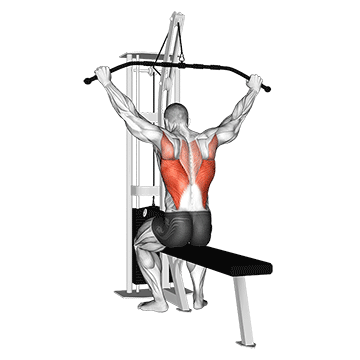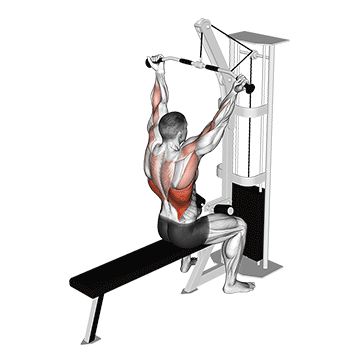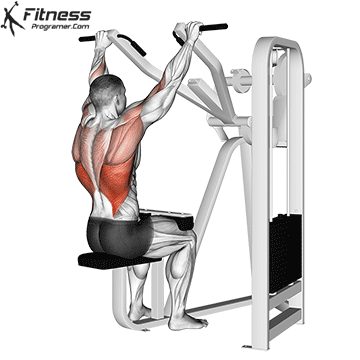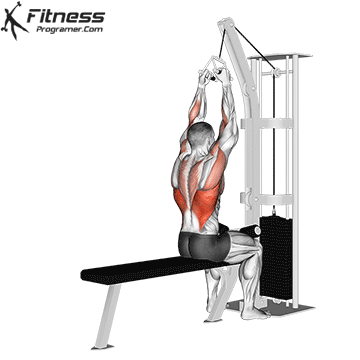Cable Rear Pulldown / Behind The Neck Pulldown
This exercise primarily targets the muscles in the upper back, especially the latissimus dorsi (lats), which are responsible for the broad and V-shaped appearance of the back.
While not recommended for everyone, some individuals with specific body structures, good flexibility, and proper form may be able to perform the exercise without experiencing issues. The primary concern is the potential for injury to the neck and shoulders due to the forced forward head tilt and extreme range of motion. This risk is particularly elevated under heavy loads.
How To do:

- Set Up:
- Use a pulldown machine with a wide grip bar attached.
- Adjust the machine to an appropriate weight.
- Sit on the machine bench facing the bar, and secure your thighs under the provided supports.
- Grip:
- Grab the bar with both hands using a wide grip. In a wide grip, your hands are positioned wider than shoulder-width apart.
- Body Position:
- Lean forward slightly while maintaining a straight back.
- Ensure your thighs are securely positioned under the supports to stabilize your body.
- Movement:
- Pull the bar down behind your head by bringing your elbows out to the sides.
- Focus on squeezing your shoulder blades together as you pull the bar down.
- Lower the bar until it’s close to the back of your neck, and you feel a contraction in your lat muscles.
- Controlled Release:
- Allow the cable to raise the bar back up slowly.
- Fully extend your arms and shoulders at the top of the movement.
- Repeat:
- Perform the desired number of repetitions, maintaining control throughout the exercise.
Tips:
- Ensure a smooth and controlled movement, avoiding any jerking or swinging.
- Keep your back straight and chest up throughout the exercise.
- Do not use excessively heavy weights that compromise your form.
Individual Assessment:
- Consider your own body’s limitations, flexibility, and structural considerations. If you have a history of neck or shoulder issues, it may be prudent to avoid behind-the-neck exercises altogether.
Cable Rear Pulldown Benefits
The behind-the-neck lat pull-down can effectively target the muscles of the upper back, including the latissimus dorsi, rhomboids, and trapezius.
Some individuals may feel a different range of muscle activation compared to traditional lat pull-downs. This variation could be beneficial for those seeking to add diversity to their workout routines.
The cable rear lat pulldown provides a variation to traditional lat pulldowns and other upper back exercises. Introducing different movements into your training routine can help prevent plateaus and keep your workouts engaging.
Risk to Neck and Shoulders:
Behind-the-neck exercises can force the neck and shoulders into potentially risky positions, particularly as the head tilts forward during the movement. The exercise involves significant abduction and external rotation of the shoulders, placing them in an extreme range of motion. This misalignment with the spine can lead to increased stress on the neck joints.
While some individuals may perform the exercise without apparent issues, the risk varies based on factors such as individual anatomy, flexibility, and technique. However, the potential for injury is higher compared to alternative exercises.
Each person’s body is unique, and what works for one individual may not be suitable for another. Individuals considering the behind-the-neck lat pull-down should assess their own flexibility, body structure, and any pre-existing conditions.
Cable Rear Pulldown – Muscles Worked





